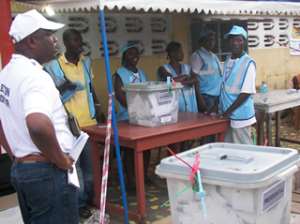
Migration data in Ghana, like all developing nations, is one of the best kept secrets. Ironically even in a first world country like the US illegal migration makes it extremely difficult to project accurate net migration rates. As such we can only tell the patterns of migration from a combination of data sources.
Mine is to locate the trend of internal migration between Ghana's regions. One such source is the Election 2008 results. The graph titled: “Plot of Population Structure Compared with Ghana Election 2008” exhibits four types of information. One is the Population Census of 2000 and the Population of persons ten years and above in 2000 (from Ghana Statistical Service publications). The assumption here is that all those who were 10 years and above in 2000 would be 18 years in 2008, and therefore eligible to vote. It is further assumed that those who were 18 in 2008 were able to register before Election 2008. The third category of data is the number of registered voters for Election 2008 and as well number of persons who actually voted in Election 2008.
An examination of a graph on the population shows the possible movement of persons within Ghana. This movement could be a result of moving to work in another region or movement from one region to another in order to vote. Even if the later reason is proven, it gives an idea how many persons do not live in their region of birth.
The graph shows that the 2000 census cohort of the 10-year olds moved proportional to the Pop Census data in all regions except the Northern and Eastern regions. This could be due to changes in death and birth rates and as well migration to other regions. I would prefer migration as the main cause. This means it is very likely that there were movements from these regions to other parts of Ghana. The lines for Upper East and Upper West are converging with the census data. This means the difference between the total population and the 10-year olds and above is very small. Could this be population ageing?
The most dramatic result is the number of registered voters versus the 2000 population cohort of 10 years and above for Greater Accra region. The number of registered persons in Accra is far more than the population to be aged 18 and above in 2008. Coincidentally those who actually voted in Accra did not show any corresponding trend with the number of registered voters in Accra. Reasons for this could be the likely higher birth rates or lower death rates in Accra region.
The most likely conclusion here is that there are higher movements into the Greater Accra region. Accra is the first destination for migrants.
Granting that those who actually migrate are persons younger and more active then the population of the Greater Accra region should be young. This conclusion should call for much headache for policy makers. Accra needs more resources to contain the extra persons who migrate here.
(NB. The author would send a black-and-white copy to any one who may need it.)
Credit: Paul A. Agbodza
(Atikpui, via Ho)
[Email: [email protected]]




 As an incoming president I’m committed to charting a new vision for our mining s...
As an incoming president I’m committed to charting a new vision for our mining s...
 Social media can be productive platform for youth if used well — Archbishop Palm...
Social media can be productive platform for youth if used well — Archbishop Palm...
 You can't close your vigil at midnight; it will compromise security — Police to ...
You can't close your vigil at midnight; it will compromise security — Police to ...
 May 16: Rainstorms from Togo, Nigeria approaching Ghana mid-morning into the aft...
May 16: Rainstorms from Togo, Nigeria approaching Ghana mid-morning into the aft...
 He proposed marriage to me online while in abroad — Celestine Donkor reveals how...
He proposed marriage to me online while in abroad — Celestine Donkor reveals how...
 Having one hit-song after 20-years makes you worthless of my attention — Strongm...
Having one hit-song after 20-years makes you worthless of my attention — Strongm...
 ‘It was painful, annoying’ — Sister Derby opens up on Medikal and Fella’s relati...
‘It was painful, annoying’ — Sister Derby opens up on Medikal and Fella’s relati...
 It's baseless, without foundation — Lawyer denies allegations of stealing client...
It's baseless, without foundation — Lawyer denies allegations of stealing client...
 Bawumia’s claim of cedi performing better under NPP government than Mahama ridic...
Bawumia’s claim of cedi performing better under NPP government than Mahama ridic...
 Henry Quartey has shown that I got him whatever he’s enjoying now – Shiekh IC Qu...
Henry Quartey has shown that I got him whatever he’s enjoying now – Shiekh IC Qu...
